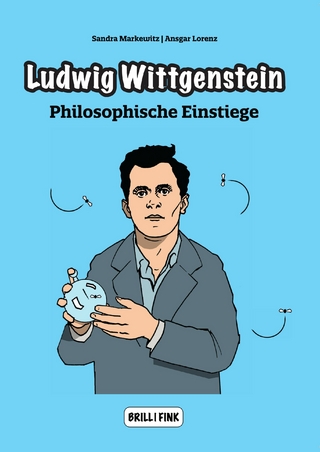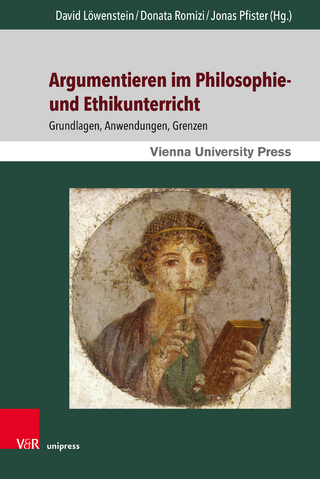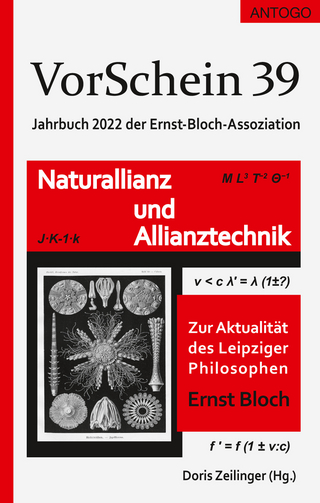
Logic
Pearson (Verlag)
978-0-13-193312-5 (ISBN)
- Titel ist leider vergriffen;
keine Neuauflage - Artikel merken
Logic offers students a comprehensive yet accessible introduction to the fundamentals of logical thinking. In addition to clear and detailed coverage of logic theory, author Stan Baronett emphasizes real-world applications of the principles of logic. Because of this dual focus—on how to think logically as well as how to apply logic in everyday situations—this text shows students how life takes logic.
Author Stan Baronett employs a clear and accessible writing style in which he addresses the reader as if they are in one-on-one discussion. Throughout the text, Baronett anticipates, asks, and answers the questions that typically arise during discussion of each topic–leading readers to a deeper understanding of the material.
Brief Table of Contents:
Chapter 1 Logic and Truth
Chapter 2 Inferences: Assessment, Recognition, and Reconstruction
Chapter 3 Categorical Statements and Inferences
Chapter 4 Truth-functional Statements
Chapter 5 Truth Tables and Proofs
Chapter 6 Natural Deduction
Chapter 7 The Logic of Quantifiers
Chapter 8 Logic and Language
Chapter 9 Applied Inductive Analysis
Appendix 1 Mapping Premises and Conclusions
Appendix 2 The Square of Opposition and Standard-form Categorical
Expanded Table of Contents:
Chapter 1 Logic and Truth
1.1 Truth Content and Logical Component
1.2 Logic and Relationships
Exercise Set–1.2
1.3 Truth Content Errors, Logical Component Errors, and the Analysis of Inferences
Exercise Set–1.3
1.4 Reasoning, Judgment, and Deductive Analysis
Equivocation
Exercise Set–1.4
1.5 Deductive and Inductive Inferences
Deductive Inferences
Inductive Inferences
1.6 Uncertainty and Inductive Analysis
Exercise Set–1.6
Summary
Key Terms
Thinking Logically: The Problem of the Hats
Biography: The Women Who Programmed ENIAC
Biography: Blaise Pascal
Chapter 2 Inferences: Assessment, Recognition, and Reconstruction
2.1 The Role of New Evidence
Exercise Set–2.1
2.2 Inference Analysis and Evaluation
Exercise Set–2.2
2.3 Logical Structure
More on Equivocation and Stipulations
Logical Loop
Logical Possibilities
Adding New Premises
Exercise Set–2.3
2.4 Expanding Skills
Recognizing and Reconstructing Inferences
Exercise Set–2.4A
Explanations
Exercise Set–2.4B
Missing Information
Exercise Set–2.4C
Summary
Key Terms
Thinking Logically: A Classic Problem
Biography: Augusta Ada Byron
Chapter 3 Categorical Statements and Inferences
3.1 Categorical Statements
Translating Ordinary Sentences into Categorical Statements
Diagramming Categorical Statements: Venn Diagrams
All Sare P
No Sare P
Some Sare P
Some Sare not P
Exercise Set–3.1
3.2 Categorical Syllogisms
Exercise Set–3.2
Summary
Key Terms
Thinking Logically: A Group Problem
Biography: Aristotle Biography: John Venn
Chapter 4 Truth-functional Statements 4.1 Logical Operators
Conjunction
Negation
Disjunction
Exercise Set–4.1A
Translations and Common Terms
Exercise Set–4.1B
4.2 Conditional Statements
Understanding and Diagramming Conditional Statements
“If” and “Only if”
Exercise Set–4.2
4.3 Rules for Symbolic Notation
Well-formed Formulas
Exercise Set--4.3A
The Main Logical Operator
Exercise Set–4.3B
4.4 Truth Tables for Complex Truth-functional Statements Order of Operations
4.5 Contingent and Noncontingent Statements Tautology
Self-contradiction
Exercise Set–4.5A
Material Equivalence
Exercise Set–4.5B
4.6 Logical Equivalence Exercise Set–4.6
4.7 Contradictory, Consistent, and Inconsistent Statements
Exercise Set–4.7
Summary
Key Terms
Thinking Logically: A Tricky Problem
Biography: The Stoics Biography: Leonhard Euler
Chapter 5 Truth Tables and Proofs
5.1 Truth Tables and Inferences
A Note on Technical Validity
Exercise Set–5.1A
Conditional Inferences
Modus Ponens
Fallacy of Affirming the Consequent
Modus Tollens
Fallacy of Denying the Antecedent
Analyzing Complex Inferences
Exercise Set–5.1B
5.2 Indirect Truth Tables
Thinking Through A Proof
An Indirect Truth Table
Exercise Set–5.2
5.3 Sufficient and Necessary Conditions Sufficient Conditions
Necessary Conditions
Analyzing Conditional Inferences
Exercise Set–5.3
Summary
Key Terms
Thinking Logically: A Guilty Problem
Biography: Charles Peirce
Chapter 6 Natural Deduction
6.1 Proving Validity Using Natural Deduction
6.2 Rules of Inference — Part One
1. Addition (Add)
2. Conjunction (Conj.)
3. Modens Ponens (MP)
4. Modus Tollens (MT)
6.3 Justification — Applying the Rules of Inference
Exercise Set--6.3
6.4 Rules of Inference — Part Two
5. Disjunctive Syllogism (DS)
6. Hypothetical Syllogism (HS)
7. Constructive Dilemma (CD)
8. Simplification (Simp)
Exercise Set–6.4
6.5 Tactics and Strategy Using the Rules of Inference
Using Natural Deduction
Working Through Proofs
Exercise Set–6.5
6.6 Substitution Sets — Group One
9. Association (Assoc)
10. Double Negation (DN)
11. Commutation (Comm)
12. De Morgan (DeM)
13. Distribution (Dist)
Exercise Set–6.6
6.7 Substitution Sets — Group Two
14. Transposition (Trans)
15. Material Implication (MI)
16. Exportation (Exp)
17. Material Equivalence (ME)
18. Tautology (Taut)
Expanding the Proof Procedure
Exercise Set–6.7
6.8 Conditional Proof
Exercise Set–6.8
6.9 Indirect Proof -- Reductio ad Absurdum
Exercise Set–6.9
Summary
Key Terms
Thinking Logically: A Standing Problem
Biography: Gerhard Gentzen
Biography: Augustus DeMorgan
Chapter 7 The Logic of Quantifiers
7.1 Prelude to the Logic of Quantifiers
Exercise Set–7.1
7.2 Integrating Categorical and Truth-functional Statements
Exercise Set–7.2
7.3 Quantification
7.4 Statement Functions and Categorical Statements
Normal-form Formulas
Bound and Free Variables
Complex Statements
Exercise Set–7.4
7.5 Quantification and Proofs of Validity
Universal Instantiation
Universal Generalization
Existential Instantiation
Existential Generalization
Conditional Proof and Indirect Proof Using Quantifiers
Exercise Set–7.5
7.6 Quantification and Proofs of Invalidity
Exercise Set–7.6
Summary
Key Terms
Thinking Logically: An Arrangement Problem
Biography: George Boole
Biography: Gottlob Frege
Chapter 8 Logic and Language
8.1 Definitions
Lexical Definitions
Stipulative Definitions
Precising Definitions
Operational Definitions
Functional and Ostensive Definitions
Exercise Set–8.1
Summary
8.2 Informal Fallacies
Fallacies of Ambiguity
1. Equivocation
2. Amphiboly
3. Composition
4. Division
5. Emphasis
6. Straw Man Fallacy
7. Red Herring Fallacy
Exercise Set---8.2A
Fallacies of Unwarranted Assumption
1. Begging the Question
2. Complex Question
3. Hasty generalization
4. Biased sample
5.Hasty application of a generalization
6. Fake Precision
7. Coincidence
8. Post hoc
9. Common Cause
10. Slippery slope
Exercise Set---8.2B
Fallacies of Relevance
1. Ad hominem
2. Tu Quoque
3. Appeal to Emotion
4. Appeal to Pity
5. Appeal to Force
6. Inference from Ignorance
7. Irrelevant Conclusion
8. Appeal to Inappropriate Authority
Exercise Set–8.2C
Summary
8.3 Rhetorical Language
Rhetorical Questions
Rhetorical Conditionals
Rhetorical Disjunctions
Exercise Set–8.3
Summary
Thinking Logically: A Clever Problem
Biography: Arthur Schopenhauer
Chapter 9 Applied Inductive Analysis
9.1 Analogical Reasoning Structure of Analogical Inferences
Exercise Set–9.1A
Analyzing Analogical Inferences
Exercise Set–9.1B
Strategies of Evaluation
Disanalogy
Counteranalogy
Unintended Consequence of the Analogy
Exercise Set–9.1C
9.2 Statistical Reasoning and Probability Theory
Analyzing Statistical Inferences
Samples and Populations
Exercise Set–9.2A
A Priori Theory of Probability
Relative Frequency Theory of Probability
Subjectivist Theory of Probability
Probability Calculus
Conjunction Methods
Disjunction Methods
Negation Method
Exercise Set–9.2B
True Odds in Games of Chance
Bayesian Theory
Exercise Set–9.2C
9.3 Scientific and Causal Reasoning
Theoretical and Experimental Science
Cause-Effect Analysis
Hypotheses, Experiments, and Predictions
Verifiable Predictions
Nontrivial Predictions
Connection Between Prediction and Hypothesis
Exercise Set–9.3
9.4 A Medical Mystery
Exercise Set–9.4
Summary
Key Terms
Thinking Logically: A Perplexing Problem
Biography: David Hume
Appendix 1 Mapping Premises and Conclusions
Exercise Set–A1
Summary
Key Terms
Appendix 2 The Square of Opposition and Standard-form Categorical
Syllogisms
A2.1 Categorical Statements
Exercise Set–A2.1
A2.2 Quantity, Quality, and Distribution
Exercise Set–A2.2
A2.3 The Aristotelian Square of Opposition
Exercise Set–A2.3
A2.4 Immediate Inferences -- Conversion, Obversion, and Contraposition
Conversion
Obversion
Contraposition
Exercise Set–A2.4
A2.5 The Problem of Existential Import and Its Consequences
A2.6 The Boolean Square of Opposition
A2.7 Conversion, Obversion, and Contraposition Revisited
Exercise Set–A2.7
A2.8 Creating Standard-form Categorical Syllogisms
A2.9 Diagramming Categorical Syllogisms
Exercise Set–A2.9
A2.10 Mood and Figure in Categorical Syllogisms
Exercise Set–A2.10
A2.11 Rules and Fallacies Associated with Standard-form Categorical Syllogisms
Exercise Set–A2.11
Summary
Key Terms
Biography: Christine Ladd-Franklin
| Erscheint lt. Verlag | 13.2.2008 |
|---|---|
| Sprache | englisch |
| Maße | 253 x 212 mm |
| Gewicht | 886 g |
| Themenwelt | Geisteswissenschaften ► Philosophie ► Logik |
| ISBN-10 | 0-13-193312-4 / 0131933124 |
| ISBN-13 | 978-0-13-193312-5 / 9780131933125 |
| Zustand | Neuware |
| Haben Sie eine Frage zum Produkt? |
aus dem Bereich



